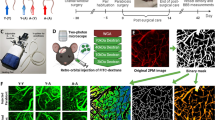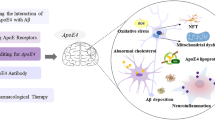Abstract
Hydroxysafflor yellow A (HSYA) has angiogenesisregulating and neuro-protective effects, but its effects on vascular dementia (VaD) are unknown. In this study, 30 adult Sprague-Dawley rats were randomly allocated to five groups: normal, sham-operation, VaD alone (bilateral carotid artery occlusion), VaD plus saline (control), and VaD plus HSYA. One week after operation, the HSYA group received one daily tail-vein injection of 0.6 mg/100 g HSYA for two weeks. Five weeks after operation, the spatial memory of all five groups was evaluated by the water maze task, and synaptic plasticity in the hippocampus was assessed by the long-term potentiation (LTP) method. Vascular endothelial growth factor (VEGF) and N-methyl-Daspartic acid receptor 1 (NR1) expression in the hippocampus was detected via Western blot. We found that, compared with the group with VaD alone, the group with HSYA had a reduced escape latency in the water maze (P < 0.05), and the LTP at CA3-CA1 synapses in the hippocampus was enhanced (P < 0.05). Western blot in the late-phase VaD group showed slight up-regulation of VEGF and downregulation of NR1 in the hippocampus, while HSYA significantly up-regulated both VEGF and NR1. These results suggested that HSYA promotes angiogenesis and increases synaptic plasticity, thus improving spatial learning and memory in the rat model of VaD.
Similar content being viewed by others
References
Kalaria RN, Maestre GE, Arizaga R, Friedland RP, Galasko D, Hall K, et al. Alzheimer’s disease and vascular dementia in developing countries: prevalence, management, and risk factors. Lancet Neurol 2008, 7: 812–826.
Ronnemaa E, Zethelius B, Lannfelt L, Kilander L. Vascular risk factors and dementia: 40-year follow-up of a populationbased cohort. Dement Geriatr Cogn Disord 2011, 31: 460–466.
Bliss TV, Collingridge GL. A synaptic model of memory: longterm potentiation in the hippocampus. Nature 1993, 361: 31–39.
Dupret D, O’Neill J, Pleydell-Bouverie B, Csicsvari J. The reorganization and reactivation of hippocampal maps predict spatial memory performance. Nat Neurosci 2010, 13: 995–1002.
Micu I, Jiang Q, Coderre E, Ridsdale A, Zhang L, Woulfe J, et al. NMDA receptors mediate calcium accumulation in myelin during chemical ischaemia. Nature 2006, 439: 988–992.
Dalmau J, Tuzun E, Wu HY, Masjuan J, Rossi JE, Voloschin A, et al. Paraneoplastic anti-N-methyl-D-aspartate receptor encephalitis associated with ovarian teratoma. Ann Neurol 2007, 61: 25–36.
Gielen M, Siegler Retchless B, Mony L, Johnson JW, Paoletti P. Mechanism of differential control of NMDA receptor activity by NR2 subunits. Nature 2009, 459: 703–707.
Liu Z, Zhao W, Xu T, Pei D, Peng Y. Alterations of NMDA receptor subunits NR1, NR2A and NR2B mRNA expression and their relationship to apoptosis following transient forebrain ischemia. Brain Res 2010, 1361: 133–139.
Vacotto M, Rapacioli M, Flores V, de Plazas SF. Acute hypoxia differentially affects the NMDA receptor NR1, NR2A and NR2B subunit mRNA levels in the developing chick optic tectum: stage-dependent plasticity in the 2B-2A ratio. Neurochem Res 2010, 35: 1609–1619.
Ferrara N. Vascular endothelial growth factor: basic science and clinical progress. Endocr Rev 2004, 25: 581–611.
Cao L, Jiao X, Zuzga DS, Liu Y, Fong DM, Young D, et al. VEGF links hippocampal activity with neurogenesis, learning and memory. Nat Genet 2004, 36: 827–835.
Schanzer A, Wachs FP, Wilhelm D, Acker T, Cooper-Kuhn C, Beck H, et al. Direct stimulation of adult neural stem cells in vitro and neurogenesis in vivo by vascular endothelial growth factor. Brain Pathol 2004, 14: 237–248.
Meselhy MR, Kadota S, Momose Y, Hatakeyama N, Kusai A, Hattori M, et al. Two new quinochalcone yellow pigments from Carthamus tinctorius and Ca2+ antagonistic activity of tinctormine. Chem Pharm Bull (Tokyo) 1993, 41: 1796–1802.
Han B, Zhao H. Effects of hydroxysafflor yellow A in the attenuation of MPTP neurotoxicity in mice. Neurochem Res 2010, 35: 107–113.
Ye SY, Gao WY. Hydroxysafflor yellow A protects neuron against hypoxia injury and suppresses inflammatory responses following focal ischemia reperfusion in rats. Arch Pharm Res 2008, 31: 1010–1015.
Bie XD, Han J, Dai HB. Effects of hydroxysafflor yellow A on the experimental traumatic brain injury in rats. J Asian Nat Prod Res 2010, 12: 239–247.
Ji DB, Zhang LY, Li CL, Ye J, Zhu HB. Effect of Hydroxysafflor yellow A on human umbilical vein endothelial cells under hypoxia. Vascul Pharmacol 2009, 50: 137–145.
Shan LQ, Ma S, Qiu XC, Zhou Y, Zhang Y, Zheng LH, et al. Hydroxysafflor Yellow A protects spinal cords from ischemia/reperfusion injury in rabbits. BMC Neurosci 2010, 11: 98.
Yang Q, Yang ZF, Liu SB, Zhang XN, Hou Y, Li XQ, et al. Neuroprotective effects of hydroxysafflor yellow A against excitotoxic neuronal death partially through down-regulation of NR2B-containing NMDA receptors. Neurochem Res 2010, 35: 1353–1360.
Morris R. Developments of a water-maze procedure for studying spatial learning in the rat. J Neurosci Methods 1984, 11: 47–60.
Vorhees CV, Williams MT. Morris water maze: procedures for assessing spatial and related forms of learning and memory. Nat Protoc 2006, 1: 848–858.
Bliss TV, Lomo T. Long-lasting potentiation of synaptic transmission in the dentate area of the anaesthetized rabbit following stimulation of the perforant path. J Physiol 1973, 232: 331–356.
Bannerman DM, Good MA, Butcher SP, Ramsay M, Morris RG. Distinct components of spatial learning revealed by prior training and NMDA receptor blockade. Nature 1995, 378: 182–186.
Jeffery KJ, Morris RG. Cumulative long-term potentiation in the rat dentate gyrus correlates with, but does not modify, performance in the water maze. Hippocampus 1993, 3: 133–140.
Morris RG, Davis S, Butcher SP. Hippocampal synaptic plasticity and NMDA receptors: a role in information storage? Philos Trans R Soc Lond B Biol Sci 1990, 329: 187–204.
Moser EI, Krobert KA, Moser MB, Morris RG. Impaired spatial learning after saturation of long-term potentiation. Science 1998, 281: 2038–2042.
Dingledine R, Borges K, Bowie D, Traynelis SF. The glutamate receptor ion channels. Pharmacol Rev 1999, 51: 7–61.
Morris RG, Anderson E, Lynch GS, Baudry M. Selective impairment of learning and blockade of long-term potentiation by an N-methyl-D-aspartate receptor antagonist, AP5. Nature 1986, 319: 774–776.
Sakimura K, Kutsuwada T, Ito I, Manabe T, Takayama C, Kushiya E, et al. Reduced hippocampal LTP and spatial learning in mice lacking NMDA receptor epsilon 1 subunit. Nature 1995, 373: 151–155.
Tsien JZ, Huerta PT, Tonegawa S. The essential role of hippocampal CA1 NMDA receptor-dependent synaptic plasticity in spatial memory. Cell 1996, 87: 1327–1338.
Senger DR, Galli SJ, Dvorak AM, Perruzzi CA, Harvey VS, Dvorak HF. Tumor cells secrete a vascular permeability factor that promotes accumulation of ascites fluid. Science 1983, 219: 983–985.
Shen H, Clauss M, Ryan J, Schmidt AM, Tijburg P, Borden L, et al. Characterization of vascular permeability factor/vascular endothelial growth factor receptors on mononuclear phagocytes. Blood 1993, 81: 2767–2773.
Haigh JJ, Morelli PI, Gerhardt H, Haigh K, Tsien J, Damert A, et al. Cortical and retinal defects caused by dosagedependent reductions in VEGF-A paracrine signaling. Dev Biol 2003, 262: 225–241.
Raab S, Beck H, Gaumann A, Yuce A, Gerber HP, Plate K, et al. Impaired brain angiogenesis and neuronal apoptosis induced by conditional homozygous inactivation of vascular endothelial growth factor. Thromb Haemost 2004, 91: 595–605.
Breier G, Albrecht U, Sterrer S, Risau W. Expression of vascular endothelial growth factor during embryonic angiogenesis and endothelial cell differentiation. Development 1992, 114: 521–532.
Breier G, Clauss M, Risau W. Coordinate expression of vascular endothelial growth factor receptor-1 (flt-1) and its ligand suggests a paracrine regulation of murine vascular development. Dev Dyn 1995, 204: 228–239.
Maurer MH, Tripps WK, Feldmann RE Jr, Kuschinsky W. Expression of vascular endothelial growth factor and its receptors in rat neural stem cells. Neurosci Lett 2003, 344: 165–168.
Meng H, Zhang Z, Zhang R, Liu X, Wang L, Robin AM, et al. Biphasic effects of exogenous VEGF on VEGF expression of adult neural progenitors. Neurosci Lett 2006, 393: 97–101.
Ji DB, Zhu MC, Zhu B, Zhu YZ, Li CL, Ye J, et al. Hydroxysafflor yellow A enhances survival of vascular endothelial cells under hypoxia via upregulation of the HIF-1 alpha-VEGF pathway and regulation of Bcl-2/Bax. J Cardiovasc Pharmacol 2008, 52: 191–202.
Zhang Q, Niu X, Yan Y, Jin M, Yang XZ, Li JR. Research on the mechanism of hydroxysafflor yellow A in inhibiting ngiogenesis. J Beijing Univ Tradit Chin Med 2004, 27: 25–29.
Author information
Authors and Affiliations
Corresponding author
Rights and permissions
About this article
Cite this article
Zhang, N., Xing, M., Wang, Y. et al. Hydroxysafflor yellow A improves learning and memory in a rat model of vascular dementia by increasing VEGF and NR1 in the hippocampus. Neurosci. Bull. 30, 417–424 (2014). https://doi.org/10.1007/s12264-013-1375-2
Received:
Accepted:
Published:
Issue Date:
DOI: https://doi.org/10.1007/s12264-013-1375-2




